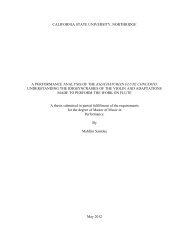Page 1 The California ""- Geographer Annual Publication of the ...
Page 1 The California ""- Geographer Annual Publication of the ...
Page 1 The California ""- Geographer Annual Publication of the ...
Create successful ePaper yourself
Turn your PDF publications into a flip-book with our unique Google optimized e-Paper software.
had records which were adjudged to be homogeneous. <strong>The</strong> quality <strong>of</strong> all<br />
precipitation data used was checked for homogeneity by <strong>the</strong> double-mass<br />
plot system. In <strong>the</strong> case <strong>of</strong> temperature records <strong>the</strong> regression line method<br />
was utilized somewhat as a guide to station validity, but because <strong>of</strong> a<br />
general lack <strong>of</strong> temperature data compared to precipitation, temperature<br />
information was generally accepted at face value. Also, because <strong>of</strong> this lack<br />
<strong>of</strong> temperature data in some key areas, shorter mean periods than <strong>the</strong><br />
1931-1952 base period were utilized in some instances.<br />
DISCUSSION<br />
In his paper <strong>of</strong> 1926 RusselF made certain modi£cations <strong>of</strong> Koppen's<br />
classi£cation in order to better suit <strong>California</strong> and show more detail. For<br />
instance, <strong>the</strong> boundary between "C" and "D" climates as Koppen gave it is<br />
26.6°F. Any station with an average temperature for <strong>the</strong> coldest month <strong>of</strong><br />
26.6°F. or below would be classi£ed as "D," and anything warmer, up to<br />
64.4°F. for <strong>the</strong> average <strong>of</strong> <strong>the</strong> coldest month, as "C." However, Russell<br />
shows justi£cation for changing this boundary between "C" and "D"<br />
climates to 32.0°F. He thought that a brief cold period may not be as effective<br />
on <strong>the</strong> vegetation cover as a longer, less intense one. <strong>The</strong> important<br />
thing according to Russell was whe<strong>the</strong>r or not <strong>the</strong> ground freezes signi£cantly<br />
each winter. As one goes up <strong>the</strong> west slope <strong>of</strong> <strong>the</strong> Sierra Nevada<br />
a de£nite vegetation change from <strong>the</strong> larger and more dense coniferous<br />
(Douglas Fir, Yellow Pine, Sugar Pine) forests at lower altitudes to <strong>the</strong><br />
smaller higher altitude type (Lodgepole Pine) can be seen. This change<br />
occurs more nearly <strong>the</strong> 32° iso<strong>the</strong>rm for <strong>the</strong> coldest month than <strong>the</strong> 26.6°<br />
iso<strong>the</strong>rm. Thus, <strong>the</strong> 32° average temperature for <strong>the</strong> coldest month seems<br />
better suited to <strong>California</strong>.<br />
In <strong>the</strong> arid and semi-arid climates Russell made two revisions in<br />
Koppen's classi£cation. <strong>The</strong> addition <strong>of</strong> <strong>the</strong> BWhh classi£cation to <strong>the</strong><br />
arid climates gives more detail to <strong>the</strong> desert regions <strong>of</strong> sou<strong>the</strong>astern <strong>California</strong>,<br />
and <strong>the</strong> revision <strong>of</strong> <strong>the</strong> quantitative limit <strong>of</strong> <strong>the</strong> BSk/BSh boundary<br />
in <strong>the</strong> semi-arid areas (average temperature <strong>of</strong> <strong>the</strong> coldest month 32°F.)<br />
suits <strong>California</strong> better than <strong>the</strong> original Koppen model (average annual<br />
temperature <strong>of</strong> 64.4°). In <strong>the</strong> large area <strong>of</strong> BWh climate in sou<strong>the</strong>astern<br />
<strong>California</strong> <strong>the</strong> areas with <strong>the</strong> warmer summers have a distinctly different<br />
type <strong>of</strong> vegetation, a vegetation which is much more sparse than <strong>the</strong> "cooler"<br />
BWh desert. Also, evaporation is higher in <strong>the</strong> BWhh regions. <strong>The</strong><br />
wea<strong>the</strong>r station at Cow Creek near Greenland Ranch in Death Valley<br />
compares climatically with certain very hot and dry stations in <strong>the</strong> North<br />
African Sahara region. Average annual relative humidity in this area is<br />
among <strong>the</strong> lowest, and evaporation (averaging over 160 inches per year)<br />
<strong>the</strong> highest, in <strong>the</strong> United States. It also ranks among <strong>the</strong> world's hottest<br />
places. 8 <strong>The</strong> following table (Table 1) gives pertinent climatic data for<br />
Cow Creek.<br />
7 Russell, op. cit., pp. 73-84.<br />
8 See for example, Arnold Court, "How Hot is Death Valley?," Geographical<br />
Review, Vol. 39 (1949), pp. 214-220; and M. W. Harrington, Notes On <strong>the</strong> Climate<br />
and Meteorology af Death Valley, <strong>California</strong>, USvVB Bulleti:t;t #1, 1892.<br />
3













